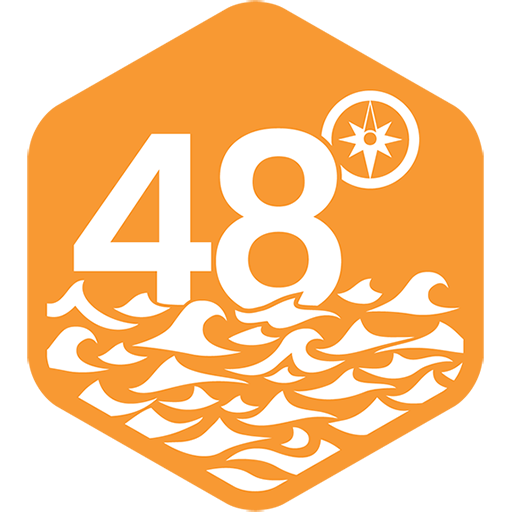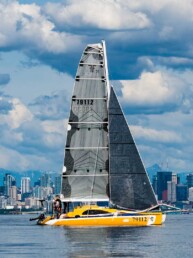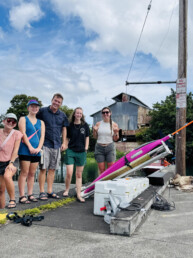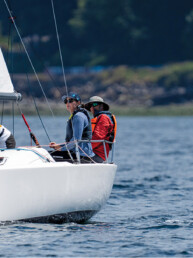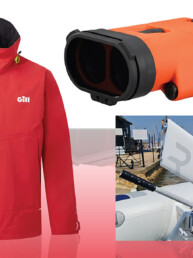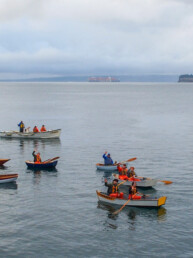A recent meeting has provided clarity and standardized language for races around the region.
Members of numerous local racing organizations recently joined a virtual discussion with Captain Alan Myers and policy leader Julie Watson from the Washington State Department of Fish and Wildlife (WDFW) to ask questions about how a new Washington State law regarding endangered killer whales will affect sailboats racing on Puget Sound, and how race rules can help racers comply with the regulations.
The State of Washington Senate Bill 5371 is now in effect, and the mandatory measures for boaters around Southern Resident killer whales (SRKW) include:
- Boaters must stay 1,000 yards (approximately 0.5 mile) in all directions from SRKWs.
- Boaters must stay below 7 knots of speed within the 1,000 yards.
- Boaters must disengage engine(s) if SRKWs appear within 400 yards.
The following questions asked of the WDFW team helped clarify the understanding for racers and organizers.
Q: How does the law pertain to racing/sailing vessels?
A: All vessels whether motorized or not are instructed to stay 1,000 yards away from SRKWs in all directions and maintain a speed of under 7 knots if they find themselves within that proximity zone. If a whale suddenly appears within 400 yards, the vessel must disengage their motor and wait until they can safely return to the 1,000 yard distance. If a whale appears near racers under sail power alone like during a race, it is advised to also decrease speed and wait until whales are out of that 400 yard proximity before moving away from the whales at a speed of under 7 knots, if it is safe to do so.
“The course of action is to get back into compliance safely and slowly, adhering to that 7 knot law,” said Captain Alan Myers. “The main goal is to stay out of the 1,000-yard protection zone, and set yourself up to do so accordingly.”
Note: Transient killer whales (Bigg’s) and other species of whales, porpoises, and dolphins are not included in the new 1,000 yard proximity update.
Q: If I am sailing and I see whales ahead that could come within 1,000 yards, what should I do?
A: The best course of action is to alter your course to avoid coming within the 1,000-yard protection zone. If they do come within 1,000 yards, maintain the law of 7 knots or less of speed. If you are unsure whether the whales are SRKWs or transients, it is safest to follow all minimum guidelines and abide by the 1,000-yard state law. It is important to consider the safety of yourself and your crew while making directional and speed changes, and to make an educated decision based on your location.
Importantly, the clarity during this meeting provided an opportunity for race organizers to standardize common language for use in their Notice of Race (NOR) and Sailing Instructions (SI) across all races. The new language was written by Dick Rose, Jared Hickman, Charley Rathkopf, and Schelleen Rathkopf, and notes that citations may be issued by WDFW when boaters are found out of compliance and, separately, that if sailors do not abide by the NOR and SI rules they could be protested or disqualified from the race.
Jon Anderson, Fleet Captain at CYC Seattle, who started this discussion with local race officers and WDFW, had this to say about the new regulations and the club’s approach:
“The CYC of Seattle is committed to ensuring all racers are set up for success while sharing the race course with these animals. Our PRO team has a plan to be more intentional about checking whale tracking apps and notifying racers before and during racing of potential whale conflicts. Additionally, during shorter buoy races, we will use best judgment and call off any racing which may impede the 1,000 yard zone. We are encouraged that many of the yacht clubs and race officials in our area are already using the new NOR language and look forward to continuing to partner across clubs and with the WDFW on these important regulations.”
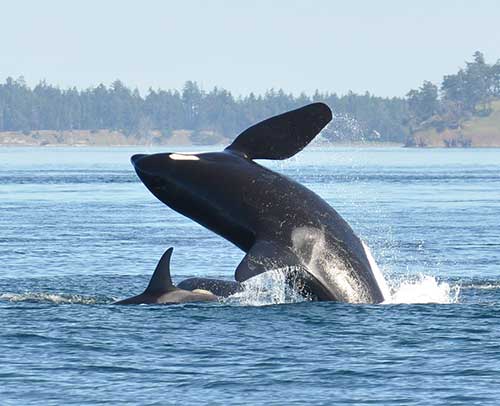 Resources for tracking whale locations
Resources for tracking whale locations
There are a number of resources sailors and Race Officers can utilize before and after hitting the water to gauge the likelihood of a whale sighting or encounter.
- Whale Alert app tracks sightings, available for Apple users
- Orca Network often reports from the water in Puget Sound
- Ocean Wise app
- Facebook groups that post sightings regularly.
- On the water tip: a “whale warning” flag can be flown by boaters to alert other vessels of nearby whales. This is a white flag with a black whale tail over a yellow and red circle.
- On the water tip: commercial whale watching boats can often be a good indicator of killer whale presence. If they appear closer to the whales – within 200-300 yards – those are most likely other species of whales, and not endangered local residents.
The Official Language You’re Likely to See in Regatta Documents
Below is the draft NOR language shared with all regional yacht clubs and organizations. Always refer to your event specific NOR for official rules for your event.
NOR / SI X State of Washington Senate Bill 5371 / Protecting Southern Resident Orcas from Vessels
NOR / SI X.1 Protecting Orcas
(a) Washington Senate Bill (SB) 5371 governs this event (see the definition Rule (g)). SB5371 states:
Operators of motorized vessels, non-motorized vessels and paddlecrafts must stay 1,000 yards (approximately one-half nautical mile) away from southern resident killer whales (SRKW) in all directions. If the SRKW approaches within 400 yards of any vessel, state law requires that the vessel disengages the transmission, luffs sails, or stops paddling (if it is safe to do so) until the animal(s) moves away. Boaters who think they may be closer than 1,000 yards to SRKW, but not within 400 yards, should attempt to navigate out of the path and away from SRKW at a speed of 7 knots or less.
(b) However, for this event the requirements of SB 5371 shall apply to all orca whales; not just SRKW.
(c) Boats may be protested for breaking NOR / SI X.
NOR / SI X.2
If an orca is seen by the crew of a boat,
(a) the boat shall not enter the circular area within 1000 yards of the orca (therefore, that area is an obstruction.); and
(b) if the boat is within 400 yards of an orca, she shall, as soon as reasonably possible, luff (or, if motoring before or after racing, disengage her transmission) to slow to the slowest safest speed, which may be to stop, until they are no longer within 1000 yards of any orca.
NOR / SI X.3 Add to RRS Rule 32.1
(e) if an individual orca or orca pod is found to be in, near, or approaching the race area.
NOR / SI X.4 Add to RRS Rule 61.4 (b):
(6) reasonable actions she took to comply with NOR / SI X.
For more information on the new mandatory measures, as well as information on Canadian laws and other species regulations, visit BeWhaleWise.org. It is always advised that participating racers familiarize themselves with the regatta documents specific to a particular event.
Images courtesy of Be Whale Wise.
